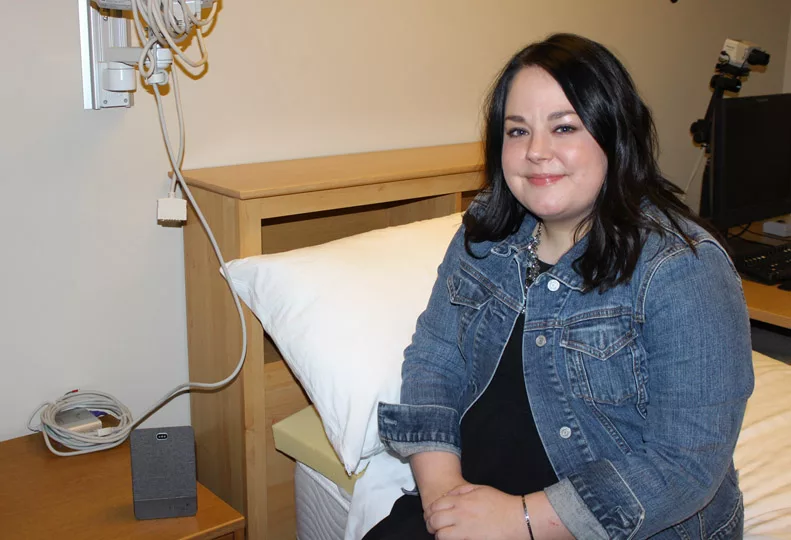WSU, UW collaborate on test for enhancing sleep
Sensor to identify insomnia patterns, suggest changes

In the future, people struggling with insomnia might get health tips for a better night’s rest from a bedside sleep-monitoring device. Such technology will be tested in both Spokane and Seattle.
To be launched today, March 1, a three-year study will involve participants in both cities with work led by researchers at Washington State University Spokane’s Sleep and Performance Research Center.
The WSU scientists will collaborate with University of Washington researchers to test the effectiveness of sleep measurement technology known as SleepScore Max, a noncontact sleep sensor that sits on a nightstand. If proven effective, it could provide a low-cost way to attack insomnia, which affects a quarter of U.S. adults and leads to lost productivity, increased health care expenses, and costs from workplace errors.
“This technology using SleepScore Max has been well-validated in other populations, including healthy sleepers and those with obstructive sleep apnea, but it’s never been looked at for individuals with insomnia,” says Devon Grant, principal investigator at WSU Spokane. “That’s the first goal: to see if this device accurately measures sleep for insomniacs.”
About the size of a nightstand alarm clock, the device emits ultralow-power radio waves that track sleep positions, respiration, wakefulness, and whether an individual gasps for air, snores, or briefly stops breathing because of sleep apnea, Grant says. A website for SleepScore Max says the device, developed by San Diego-based ResMed Inc., uses biomotion sensor technology similar to echolocation to track breathing and body movement.
“It looks at sleep staging, including deep sleep, light sleep, or REM sleep,” adds Grant, who is a postdoctoral researcher at the WSU Elson S. Floyd College of Medicine.
A companion SleepScore Max app, which can be downloaded on a smartphone or tablet, provides information and personalized advice to improve sleep.
This study is the first of its kind working over a long period of time with insomnia sufferers, Grant claims.
Starting in late spring, researchers plan to begin recruiting a total of 120 people, 30 of whom will be healthy sleepers as a control group. The other 90 people will be individuals with chronic insomnia.
Insomnia is considered chronic if someone has disrupted sleep at least three nights a week for more than three months.
The study has two main goals, Grant says. The first is to see how accurately the SleepScore technology measures the amount of sleep insomniacs manage to get each night. Secondly, researchers will examine comparisons among subgroups of the insomniacs regarding treatment effectiveness, with one option being support from SleepScore Max’s coaching feature, called its Sleep Guide.
“We’ll be looking at three groups of insomniacs and looking at treatment to see if we can differentiate,” she says. “One group is just insomniacs who get their sleep measured with no treatment or coaching support. A second group of insomniacs will have sleep measured, but also will do an online version of cognitive behavioral therapy; it’s the gold standard for insomnia because it’s found to be the most effective.”
She adds, “The third group won’t have the cognitive behavior therapy, just the Sleep Guide feature via the device, which is ultimately what we’re trying to determine, if that Sleep Guide feature is sufficient in helping people improve their sleep.”
Generally, cognitive behavioral therapy for insomniacs includes a review of the bedroom environment, considering if a person is reading in bed, watching TV, and then removing those elements that might interfere with sleep, Grant says. Other components include stress reduction, mindfulness, deep-breathing techniques, and sleep education regarding why it’s important and what sleep should look like.
The second group will be allowed to see what the device gives them for a sleeping score after each night’s sleep, but those individuals won’t receive any Sleep Guide coaching, instead just getting the online behavioral therapy. Insomniacs in the third group will receive the Sleep Guide support in addition to device monitoring and scoring, but they won’t do the online behavioral treatment.
“So every night after you sleep, your profile will be updated,” Grant says about the third insomniac group. “This is an app on your phone. Each day it will update and give you feedback on how you slept, and then it will provide you with some tips on how you can improve your sleep. You’ll receive notifications on your phone.”
The Sleep Guide provides tips that are behavioral, such as a suggestion for an individual to go to bed a little earlier, and perhaps wake up a little earlier. Such guidance might provide suggestions for improved sleep as helpful as and similar to cognitive behavioral therapy, she says.
“That’s what we’re trying to figure out,” Grant adds. “Does it provide comparable results in terms of sleep improvement compared with cognitive behavioral therapy?”
Typically, when insomniacs see a doctor for sleep disturbance, they don’t get a sleep study completed unless there is a factor such as obstructive breathing, Grant says. She adds that while a device such as a Fitbit can give helpful feedback on sleep patterns, it requires being worn, having a battery charged up, and doesn’t provide as much data as SleepScore Max, which is constantly plugged into the wall.
“Another key feature of this device is we can look at sleep over a very long period of time in person’s natural bedroom environment, where people sleep more naturally, as opposed to coming into a sleep lab,” Grant adds. “It’s not an artificial environment where the person is tethered to wires.”
“It does record; there’s a microphone,” Grant says. “The radio wave measures your movement through the night, and it will give you feedback on sleep positioning.”
A goal of the study is to monitor all participants using the SleepScore Max device for two months.
“That’s unusual, too,” Grant says. “There are not that many studies that have looked over a long period of time at people’s sleep patterns in their own natural environment. That is a hallmark insomnia concern. There is a lot of variability night to night. One night isn’t the same as another night for an insomniac.”
She adds, “If we look at two months, we can get a better idea of what insomnia sleep patterns look like.”
Researchers likely will capture the sleep of participants in waves of 10 or 20 people at a time. Data collection is expected to take a year to 18 months, followed by analysis and reporting results.
“I think another goal is that in testing this device we’re trying to see if this is another viable option for people with insomnia,” Grant says. “The primary treatment is cognitive behavioral therapy, but there aren’t many providers around to treat them. Even with treatment online, it’s still expensive at about $300, typically.”
Devices such as SleepScore Max are commercially available for purchase at about $150.
“If we find this is an effective way to improve sleep in insomniacs, this would be another option and it would be cost-effective,” she says.
A possible side benefit is such a device might help people realize they have sleep apnea, when they mistakenly think their sleeping problem is caused by insomnia, adds Grant. “It would provide good evidence they could take to their physician and help with treatment.”
She agrees that increasingly, technology is being incorporated toward health goals, and that more research is targeting how sleep contributes to health. Use of technology also is part of a trend of personalized medicine, she says, with individuals able to get more information about their body.
“Sleep is an important part of that; we spend a third of our life doing it,” she says. “Improving sleep is part of maintaining a healthy lifestyle.”
Grant adds, “We know more now about how important sleep is, although the irony about sleep is we don’t know why we sleep. But we do know what happens if we don’t get enough sleep.”
Related Articles
Related Products

_c.webp?t=1763626051)
_web.webp?t=1764835652)

